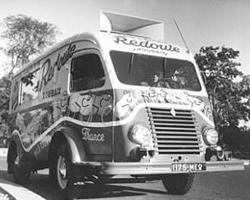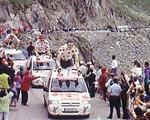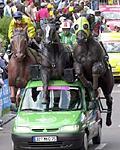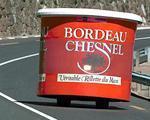
| Tour home |
| Preview |
| Photos |
| Live coverage |
| Start list |
| Stages & results |
| News |
| Map & profiles |
| Tour diaries |
| Features & tech |
| FAQ |
| Tour history |
Recently on Cyclingnews.com |
90th Tour de France - July 5-27, 2003
La Caravane du Tour de France
By Melanie Leveau
 |
With hundreds of thousands of spectators lining the roads of France to catch a glimpse of their heroes flash by, any amusement is better than no amusement. The Tour Caravane is almost as old as the Tour de France itself, and provides a unique way for sponsors to interact with the public and at the same time, relieves the boredom of a day spent waiting by the roadside.
Background and history
The Tour de France was born in 1903 but the publicity convoy or "Caravane" as it is officially known was only created in 1930. During the late 1920s, Meunier Chocolates, Lion Noir shoe polish and Bayard Alarms were already part of the convoy, but were so far behind the race, most of the spectators had already disappeared before they came through!
 |
In 1930, sponsored teams were replaced by national teams and organisers had so to find new ways to finance the race. So the Caravane was created: Meunier Chocolates distributed chocolate and paper flags to the public, and food and prize money to the riders.
The following year, the Caravane grew and had its own organisation. By the 40s and 50s, the Caravane had grown to the extent that it was nearly as popular as the race itself. Sponsors had to be full of imagination by lavishly decorating standard vehicles to attract spectators' attention to their brand names.
Between 1960 and 1990, sponsors changed and the advertising mediums grew, but the Caravane continued to remain attractive to potential advertisers despite the introduction of television advertising during the Tour.. The Caravane was still one of the best ways to reach thousands of people with a moderate investment compared to the large sums of money required for a television ad campaign. It was also a good way for regional companies to increase their brand awareness.
The Caravane today
The Caravane today is comprised of around:
40 brands across
... 300 vehicles that is around
... 20 km long and takes
... 45 minutes to pass through with
... with 10 million samples distributed each year
An award is given to the best creations, judged according to aesthetics and the respect of the Tour de France's core values: fête, conviviality, originality, fair play, fair behaviour.
Organisation
 |
The Caravane has to pass one hour before the race and must follow the peloton speed. It has to account with such factors as television schedules and the wind in order not to disturb the flow of the peloton.
To make the Caravane run like clockwork, huge ressources are deployed, involving:
- Mobile headquarters for the Caravane's director;
- Two vehicles and three motorbikes to inform drivers of the director's decisions;
- A plane which offers two radio frequencies, one for the director and the other for the whole Caravane; and,
- A GPS that gives the distance of each sponsor's vehicle's in relation to the director's car.
A word from the sponsors
 |
According to sponsors, the Tour de France is one of the best opportunities for promotion their products. With 15 million spectators each year and over a hundred million television viewers all around the world, the Tour is one of the most popular sporting events and a great environment in which to be seen. 3 out of the 10 most recalled sport sponsors in France belong to cycling: Crédit Agricole, Crédit Lyonnais and Festina.
A number of sponsors have already purchased long-term contracts, such as Coca-Cola (signed up until 2009), Nike until 2005, and France Télécom until 2006. Crédit Lyonnais has already sponsored the yellow jersey for past 20 years and has assured the Société du Tour of its commitment until 2007.
According to Nicolas Chaine, Communications Director of Crédit Lyonnais, it costs 4.35 million euros per year. This year, Fiat celebrates his 15th anniversary as a Tour sponsor with more than 500 of its vehicles participating each year. In 2003, Champion supermarkets are sponsoring the mountain classification for the tenth year running, and invest around seven million euros each year at Le Tour.
Rémy Brouard, Communications Director for Champion, says "80% of our buyers are aware of our relationship with the Tour". Nestlé Aquarel, estimate a doubling of brand awareness in regions crossed by the race since their sponsorship began last year.
Show the Société the money
Most important for the Société are the the eight "official partners", who have to pay between one to two million euros each year upfront before a cent is spent on advertising. One of those partners, PMU - a horse betting firm - is the green jersey sponsor and relies heavily on its presence at the Tour and especially in the Caravane to increase patrons' visits to their offices, particularly in July and August when the horse racing season is at its low point.
The 12 official suppliers, one level below partner status, have to pay between 350-750,000 euros to be part of the Tour and to use the Tour de France logo of the on their products and advertising material. Cochonou Saucissons, a manufacturer of dried French sausage and a past official supplier, claims to enjoy a 30 per cent increase in sales from June to August compared to the other months of the year.
Photos
Images courtesy http://perso.club-internet.fr/porsini/acceuil.htm, with loads more photos from the La Caravane du Tour, including a fantastic archive of miniatures of riders and vehicles from the last 100 years.
- Chicorée Williot were one of the first sponsors to be part of the Caravane.
- La Redoute, France's leading mail order company, has long been a supporter of the Tour de France.
- L'Equipe, the biggest selling French daily sports newspaper, is one of the main reasons why the Tour is still alive and well today.
- A Caravane vehicle from 1949.
- In 1950, the Caravane vehicles appeared to follow the 'bigger is better' principle.
- Gimme a C, gimme an A, gimme a T, gimme an O, gimme and X... what have you got? Catox!!
- The town of Nantes has hosted multiple stage finishes throughout the Tour's history.
- A BMW motorbike from 1960, as classic as the rider himself.
- Looks to us like a cross between Ulysees and the Adams Family vehicle.
- Waterman pens used the Caravane as part of their marketing strategy to compete head-on with the Parker pen company at the 1960 Tour.
- At the 1975 Tour, a Love Bug lookalike emerges from the dark.
- The Caravane strung out single file - just like the peloton.
- Look out! It's a runaway tub of potted meat, which happens to be somewhat of a speciality in France, made by stewing meat in its own fat and then shredding it. Uuuugh.
- Horse betting company PMU is one of the the Tour's eight official partners.
- The Champion supermarket chain has been a long-time supporter of the mountains competition at Le Tour.
- As the official sponsor of the mountains competition, the Champion Caravane vehicles quite fittingly lead the way through the Pyrenees in the 1993 Tour.
- In 1994, Festina watchmakers went to great lengths to display their support in the world's biggest cycling event.
- You can drink it in a minute, but the maid part we just don't get.
- Now this could quite easily be a scene from that wacky series 'Lost in Space'.
- Anyone need to phone home?
- The Caravane enter the Champs Elysées in the 1999 Tour, the first of Lance Armstrong's four victories to date.
|
